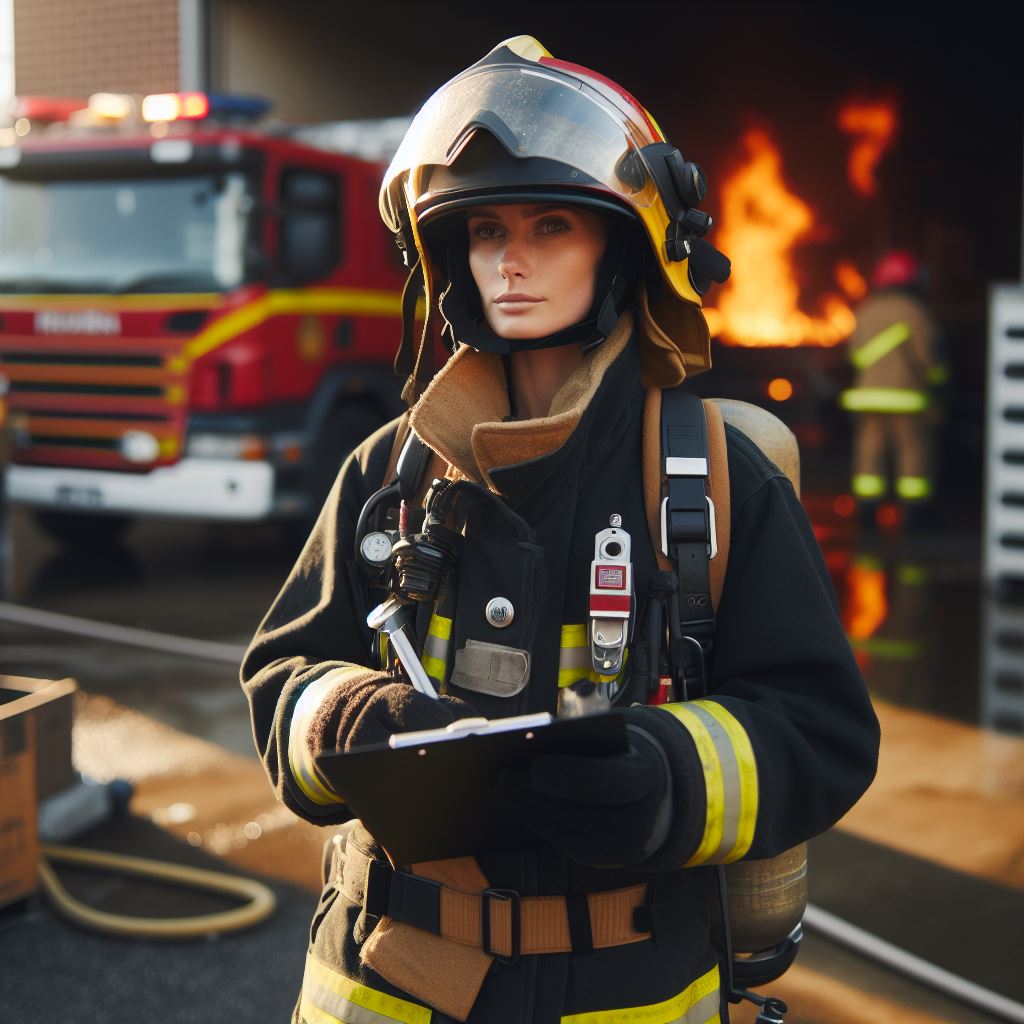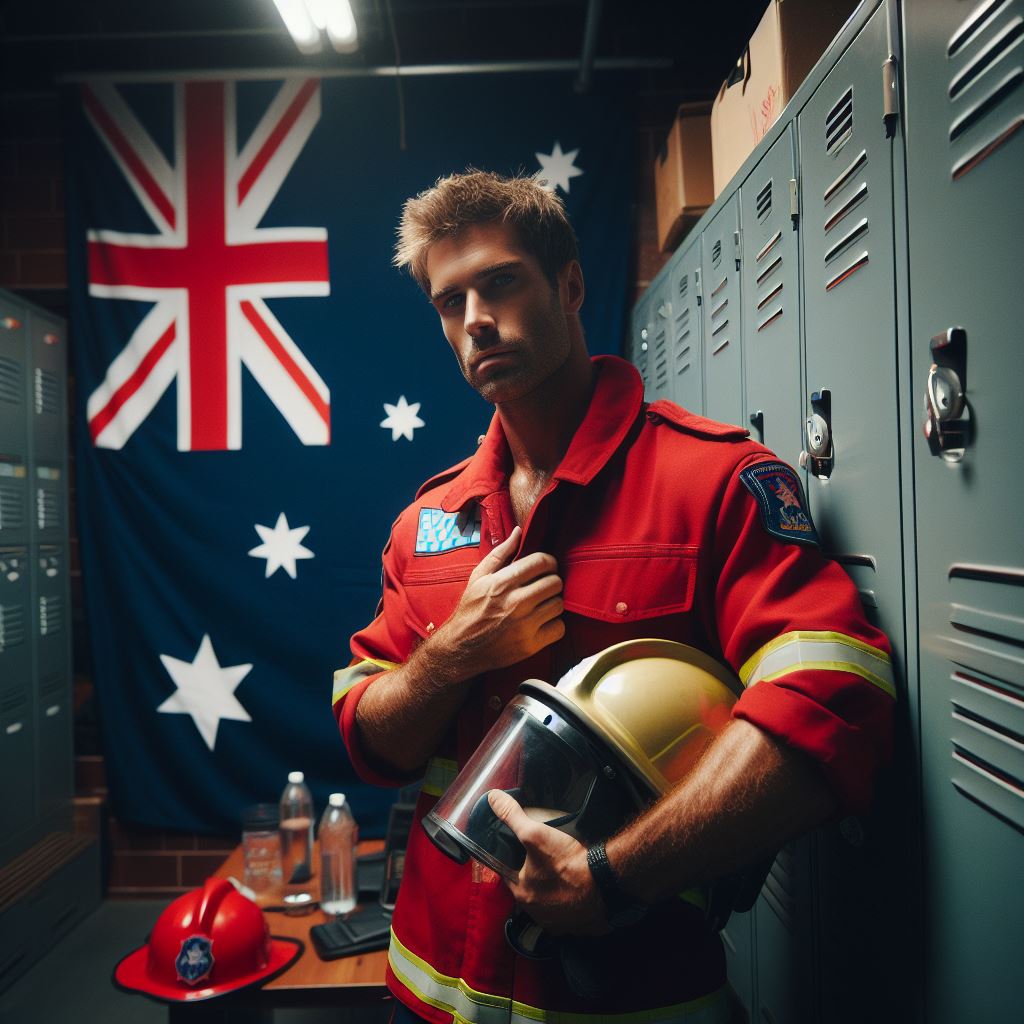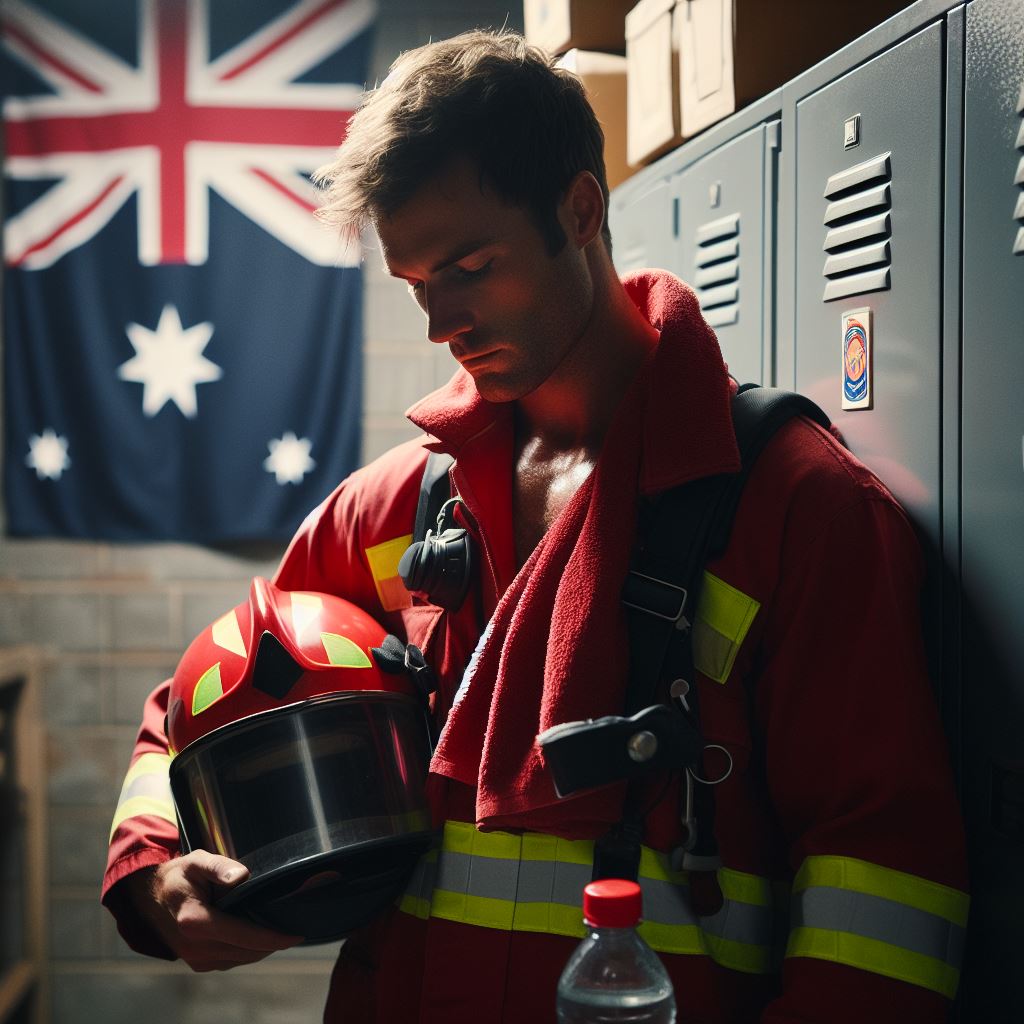Introduction
Being an Aussie firefighter is more than a profession; it’s a profound calling marked by unparalleled courage and unwavering selflessness.
In this blog, we delve into the dynamic and demanding world of these everyday heroes, shedding light on the challenges they face, the triumphs they achieve, and the noble nature of their crucial role in safeguarding lives, property, and the environment.
The Importance and Noble Nature of the Job
As flames dance and embers glow, Aussie firefighters stand tall against the infernos that threaten their communities.
Beyond the iconic yellow suits and roaring fires, their commitment extends to rescuing animals, managing hazardous materials, and aiding in various emergencies.
Their dedication goes beyond the call of duty, embodying a sense of duty and responsibility that is truly commendable.
Setting the Tone and Purpose
This blog aims to offer readers an intimate glimpse into the daily life of an Aussie firefighter, highlighting the sacrifices, resilience, and indomitable spirit that define their profession.
Through vivid narratives and firsthand accounts, we aim to honor these brave men and women who, with every alarm bell, rush into the face of danger.
Join us on this exploration as we celebrate the heroism, camaraderie, and sense of purpose that make being an Aussie firefighter an extraordinary and deeply fulfilling journey.
Overview of the Role
Being an Aussie firefighter comes with immense responsibilities and requires a diverse skill set.
Highlighting their responsibilities
- Firefighters are responsible for responding to emergency incidents involving fires, hazardous materials, and rescues.
- They ensure the safety and well-being of the public and property by minimizing the impact of emergencies.
- Firefighters also play a crucial role in educating the community about fire prevention and safety measures.
- They conduct regular inspections of buildings and facilities to ensure compliance with fire safety regulations.
- Training and preparing for emergency situations are also part of their responsibilities.
Discussing the diverse tasks they perform on a daily basis
- Firefighters constantly train and maintain their physical fitness to be prepared for any situation.
- They attend regular briefings and discuss strategies to handle specific emergencies.
- Daily routine tasks include checking and maintaining firefighting equipment and vehicles.
- They conduct drills and simulations to practice and improve their response times.
- Depending on the station’s location, firefighters may also perform community outreach programs.
Mentioning the range of emergencies they handle
- Firefighters respond to structural fires in residential, commercial, and industrial settings.
- They handle wildland fires, ensuring the safety of both people and wildlife.
- Hazardous materials incidents, such as chemical leaks or spills, require their expertise.
- Firefighters provide swift water rescue services during floods and swift-water emergencies.
- They render aid in medical emergencies and accidents, performing basic life support until paramedics arrive.
- Rescuing people from confined spaces, such as collapsed buildings or vehicles, is another challenging task.
- Firefighters are trained to handle vehicle fires and extricate individuals trapped in wrecked cars.
- They also respond to natural disasters like storms, floods, and earthquakes.
Essentially, the role of an Aussie firefighter is demanding and crucial in ensuring the safety and protection of the community.
Their responsibilities encompass responding to various emergencies, performing diverse tasks, and handling a wide range of incidents.
It is their dedication, courage, and commitment that make them the true heroes of our society.
Read: Understanding Public Sector Unions
Morning Routine
Start the Day with a Regular Briefing and Safety Check
Every dawn, Aussie firefighters gather for a briefing, emphasizing safety and critical information for the day’s operations.
This active exchange ensures everyone is informed and promotes a unified front in combating potential hazards.
Importance of Physical Fitness and Routine Exercises
Physical fitness isn’t just a routine; it’s a way of life for Aussie firefighters.
Discussions in the morning delve into the significance of staying fit, both mentally and physically.
Routine exercises, from cardiovascular workouts to strength training, build endurance for the demanding tasks they may face.
Preparation Process Before Heading Out for Duty
Before heading out for duty, Aussie firefighters engage in meticulous preparation.
From gear checks to emergency protocols, they leave no room for error when it comes to safety.
Thorough examinations of firefighting apparatus and mental readiness discussions ensure a quick and effective response to any emergency.
The day kicks off with a gathering, an active exchange of information vital for the day’s operations.
Engaging in this briefing ensures everyone is informed, promoting a unified front in combating potential hazards.
Emphasizing physical fitness is more than just a routine; it’s a way of life.
The discussions delve into the importance of staying fit, both mentally and physically.
Active bodies and alert minds are crucial in the unpredictable world of firefighting.
Routine exercises follow, ranging from cardiovascular workouts to strength training.
This physical regimen is not just about maintaining peak fitness but also about building endurance for the demanding tasks they may encounter.
Each firefighter understands the need to be at their best.
Highlighting the preparation process, discussions cover everything from gear checks to emergency protocols.
Ensuring equipment readiness is paramount.
Firefighters meticulously inspect and maintain their gear, leaving no room for error when it comes to their safety.
Read: Benefits of a Career in Public Service
On-duty Responsibilities
As an Aussie firefighter, the on-duty responsibilities are varied, demanding, and require quick thinking.
Responding to Different Incidents and Emergencies
Firefighters respond to a wide range of incidents and emergencies to protect lives and property.
- Structural Fires: They encounter intense flames, collapsing buildings, and the risk of explosions.
- Wildfires: They combat raging bushfires that threaten the natural environment and residential areas.
- Traffic Accidents: They provide immediate assistance, extricate trapped individuals, and render medical aid.
- Hazardous Material Spills: They mitigate chemical leaks, preventing environmental contamination.
- Rescues: They perform daring rescues from heights, confined spaces, and swift water scenarios.
Handling Firefighting Situations
Firefighting situations require brave and calculated actions that prioritize saving lives and minimizing property damage.
- Entering Burning Structures: Firefighters enter burning buildings to search for trapped victims.
- Suppressing Flames: They efficiently use firefighting equipment to extinguish fires as quickly as possible.
- Ensuring Safety: They secure hazardous areas, shut off utilities, and establish safe perimeters.
- Ventilating Structures: They utilize ventilation techniques to clear smoke and improve visibility.
- Performing Salvage and Overhaul: They salvage valuable property and ensure complete fire suppression.
Importance of Teamwork and Effective Communication
Teamwork and effective communication are vital for firefighters to accomplish their duties successfully.
- Collaborative Efforts: They work in close coordination with other firefighters to tackle complex incidents.
- Clear Chain of Command: They follow a hierarchical structure to maintain order and streamline operations.
- Sharing Information: They provide accurate and timely updates about the incident’s progress and risks.
- Coordinated Tactics: They synchronize their actions to maximize efficiency and minimize risks.
- Mutual Support: They rely on each other for backup, ensuring everyone’s safety during challenging tasks.
Moreover, effective communication extends beyond immediate firefighting tasks.
Your Personalized Career Strategy
Unlock your potential with tailored career consulting. Get clear, actionable steps designed for your success. Start now!
Get Started- Public Education: They educate communities about fire safety, prevention, and emergency preparedness.
- Community Engagement: They build trust and strengthen bonds with the communities they serve.
- Collaboration with Other Agencies: They liaise with police, paramedics, and disaster management authorities.
- Continuous Training and Improvement: They participate in regular training exercises to enhance skills.
- Providing Emotional Support: They comfort victims and their families during traumatic incidents.
Overall, the on-duty responsibilities of Aussie firefighters encompass a wide range of incidents, from battling intense fires to performing daring rescues.
Their success relies on strong teamwork, effective communication, and a commitment to the safety of the communities they serve.
Read; Retirement Plans for Public Sector Workers
Specialized Tasks
Firefighters extend beyond firefighting, inspecting buildings for safety compliance.
They educate communities on fire prevention through outreach programs, emphasizing safety measures.
Ongoing training equips them with the latest firefighting techniques, ensuring adaptability to new equipment and technologies.
Specializations may require certifications like Hazardous Materials Technician or Rescue Technician.
Trained in high-risk situations, they handle chemical spills and conduct rescues.
Qualifications like Emergency Medical Technician certification enable immediate medical assistance.
Incident command training ensures effective coordination during emergencies.
Some pursue higher education for enhanced leadership skills in fire administration or management.
Continuous professional development ensures readiness for any emergency.
They attend workshops, seminars, and conferences to stay updated on firefighting techniques and equipment.
Physical workouts maintain the strength, endurance, and flexibility required for operations.
Firefighters maintain valid driver’s licenses and receive specialized training for emergency vehicle operation.
Specialized training includes handling hazardous materials and performing technical rescues.
Some specialize in wildland firefighting, acquiring additional training specific to forest fires.
Strong communication skills are vital for coordinating with other emergency response teams during operations.
Firefighters educate the public on fire safety during community events or school programs.
Regular review and practice of firefighting techniques ensure swift and effective crisis responses.
Periodic physical fitness evaluations ensure they meet the job demands, preventing injuries and enabling task performance.
Peer-to-peer knowledge sharing and experience exchange within the firefighting community facilitate continuous learning.
Collaborative training exercises with other agencies foster teamwork and enhance emergency response capabilities.
Firefighters’ commitment to specialized tasks reflects dedication to protecting lives, property, and the community.
Ongoing dedication, training, and professional development make firefighters invaluable for ensuring public safety.
Read: Public Servants’ Role in Crisis Management

Learn More: The Role of Embassies in Diplomacy
Gain More Insights: The Role of Ethics in Public Service
Breaks, Meals, and Downtime
The Unpredictable Nature of Firefighters’ Schedules
Being an Aussie firefighter means one can never predict their schedule, each day brings new challenges and emergencies.
From the crack of dawn until late into the night, they are always ready to respond to any call.
Whether it’s a raging bushfire or a rescue mission, firefighters are on the front line, risking their own lives to save others.
This unpredictable nature of their work demands adaptability and mental strength to deal with the ever-changing situations.
Utilizing Breaks and Meals to Rest and Recharge
Despite the chaotic nature of their job, firefighters understand the importance of taking breaks and having regular meals.
During grueling shifts, they utilize every opportunity to refuel their bodies and minds.
Breaks are crucial for firefighters to recharge, rehydrate, and regain focus to continue tackling emergencies.
These short respites allow them to catch their breath, both literally and figuratively, and gather their thoughts.
Stand Out with a Resume That Gets Results
Your career is worth more than a generic template. Let us craft a resume and cover letter that showcase your unique strengths and help you secure that dream job.
Get HiredMeals are not just about satisfying hunger; they provide essential nutrients and energy to sustain their physical exertion.
Moreover, sharing meals together creates a sense of camaraderie and fosters teamwork among the firefighting crew.
Engaging in Activities During Downtime
When not battling fires or focusing on their intense training, firefighters also find moments of downtime to relax.
Engaging in activities during these quieter periods helps them decompress and maintain mental well-being.
Some firefighters enjoy reading, listening to music, or watching movies as a way to temporarily escape from the demands of their job.
Others prefer physical activities such as exercising or playing sports, which helps them stay fit and blow off steam.
Some use their downtime to learn new skills or attend workshops, constantly seeking personal and professional growth.
No matter the activity, downtime allows firefighters to recharge their batteries, both physically and mentally.
Breaks, meals, and downtime are essential elements in the lives of Aussie firefighters.
Despite the unpredictable nature of their schedules, they understand the importance of rest and rejuvenation.
These breaks and meals provide the necessary fuel to continue their challenging work on the front lines.
Downtime, on the other hand, offers a chance for relaxation, reflection, and personal growth.
Being a firefighter requires not only bravery and resilience but also the ability to find balance in the midst of chaos.
Next time you see a firefighter on the street, remember the sacrifices they make and the importance of their breaks, meals, and downtime.
Transform Your LinkedIn for Maximum Impact
Elevate your professional brand with a LinkedIn profile that attracts recruiters, showcases your expertise, and maximizes opportunities. Stand out in your industry with a profile built for success.
Boost ProfileRead: Diversity & Inclusion in Govt Workplaces
You Might Also Like: Women in Firefighting: Breaking Barriers
Discover More: Policy Analyst Roles in Aussie Gov: An Overview
Challenges and Rewards of Being an Aussie Firefighter
Physical and Emotional Challenges
- Firefighters face physically demanding tasks, requiring strength, agility, and endurance.
- The extreme heat, smoke, and hazardous materials pose significant health risks to firefighters.
- Exposure to traumatic events and witnessing human suffering can lead to emotional stress and psychological challenges.
- Firefighters may also experience fatigue, sleep deprivation, and disruptions in their personal lives.
Satisfaction and Sense of Purpose
- Despite the challenges, being a firefighter brings immense satisfaction and a deep sense of purpose.
- Helping people in need and saving lives gives firefighters a strong sense of fulfillment.
- Being part of a close-knit team and the camaraderie among firefighters is incredibly rewarding.
- The gratitude and respect received from the community further reinforce the sense of purpose.
Stories of Rewarding Experiences
- One time, a group of firefighters rescued a family trapped in a burning house, saving their lives.
- Another story involved a firefighter who successfully performed CPR on a collapsed individual, reviving them.
- A firefighter shared how overcoming fear and rescuing a child from a wildfire brought immense joy.
These stories demonstrate the rewarding nature of a firefighter’s role.
They showcase the importance of their skills and the positive impact they have on people’s lives.
Moreover, firefighters often witness gratitude firsthand.
They experience the heartfelt thank-yous and appreciation from those they have saved or helped during emergencies.
This recognition goes beyond words and provides firefighters with a profound sense of fulfillment.
The job also offers a unique opportunity to make a difference in the community.
Firefighters actively participate in fire prevention campaigns, educating people about safety measures and conducting drills to enhance preparedness.
Through these efforts, they help reduce the risk of fires and create a safer environment for everyone.
Additionally, the constant growth and learning inherent in a firefighter’s career contribute to personal development.
They are continually expanding their skills, embracing new technologies, and staying up-to-date with the latest firefighting tactics.
This ongoing professional advancement brings a sense of accomplishment and pride.
While the challenges can be demanding physically and emotionally, the rewards overshadow them.
Firefighters find purpose in their role, knowing they have dedicated their lives to protecting and serving their communities.
The satisfaction derived from helping others and making a positive impact makes being an Aussie firefighter a truly fulfilling and meaningful profession.
Learn More: Diplomatic Missions: Behind the Scenes
Conclusion
As we conclude our exploration into the daily life of Aussie firefighters, we witness a remarkable tapestry of dedication and resilience.
From the early morning briefings, where safety is paramount, to the unpredictable emergencies that demand immediate action, these firefighters exemplify unwavering commitment.
Their daily routine is more than a series of tasks; it’s a testament to their preparedness and the sacrifices they make for the safety of our communities.
Beyond fighting fires, they conduct educational programs, maintain physical fitness, and continuously upgrade their skills to navigate the evolving challenges they face.
The significance of their contribution to the community cannot be overstated.
Aussie firefighters are the guardians of safety, the first responders in times of crisis, and the pillars of strength that communities rely on.
Their courage and selflessness create a shield that protects lives and properties, ensuring the well-being of all.
In closing, let us express our deepest appreciation and admiration for these everyday heroes.
Their bravery and resilience inspire us, reminding us of the profound impact individuals can have when driven by a sense of duty.
To Aussie firefighters, we extend our heartfelt gratitude for their unwavering commitment to safeguarding lives and communities.




